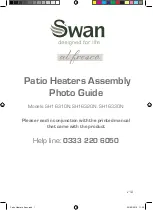
Other troubleshooting hints:
1.
Input switches can be easily checked by observing their
activation on the UIM System Status screen. Force the boiler
to remain in the Standby mode by opening the Thermostat
input or by setting the operating setpoint to the minimum so
that the system does not request heat. Then short out the
contacts on the switch and verify that an asterisk "*" appears
next to the appropriate input on the screen. If it does not
then look for the problem to be in the wiring or connectors
between the flow switch and the CCB.
2.
When troubleshooting a particular problem the heating
sequence time can be shortened by turning off the
dipswitches for operation devices that are not needed during
troubleshooting.
3
The pump can be activated during the "Standby" mode by
changing the post-circulate time to continuous.
4.
All Hi-Speed blowers can be activated for 5 minutes by
opening any Hi-Speed blower prover switch prior to turning
on the power. This activates the "shutter adjust" mode.
During this time, activation of all of the blower prover switches
can be checked on the "system status" screen.
5.
Opening the Thermostat input leads will force the system to
remain in the standby mode.
6.
Running the system with the gas turned off will allow the
system to run through all operating steps up to flame
sensing.
7.
Proper operation of the flame sensing circuit can be almost
completely verified through the use of a 14007 diode. The
anode end of the diode should be connected to the
appropriate flame sense lead and the cathode end (bar) of
the diode should be connected to the case of the boiler
(earth ground connection). Gas is not needed for this
procedure and therefore should be off. It is also desirable
to disable the command for heat by opening the thermostat
leads. After apply power the system should declare an error
because flame is being sensed at the wrong time. Shift to
the "System Status" screen and scroll down to the
appropriate "Flame" input. The asterisk "*" should appear
when the diode is connected and not when it is disconnected.
8.
The CCB can be individually checked out by setting the 10
position CCB dipswitch to off. This will make the system
operate as a single stage and disable the other FCB's.
9.
Watching the Control States screen while troubleshooting
the heating sequence will help determine what is causing
the problem. Knowing what state the CCB and FCB's are in
when the problem occurs will help to pinpoint a possible
source of the fault.
10. Write down the proper positions of the dip switches after
initial installation and compare them to the present dipswitch
setting shown on the "Configuration Settings" screen. This
will catch any accidental changing of the dipswitches.
18
Summary of Contents for 500
Page 5: ...5 Figure 1A CCB Drawing 211758...
Page 6: ...6 Figure 1B FCB Drawing 211759...
Page 7: ...7 Figure 1C PDB Drawing 211760...
Page 14: ...14 CONNECTION DIAGRAM Drawing 211769 FIGURE 4...
Page 15: ...15...
Page 20: ...20 NOTES...
Page 21: ...21 NOTES...
Page 22: ...22 NOTES...






































